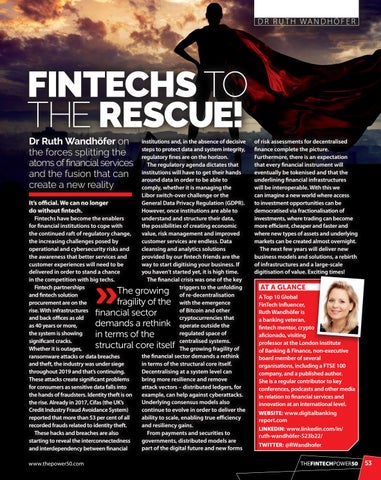D R R U T H WA N D H Ö F E R
FINTECHS TO THE RESCUE! Dr Ruth Wandhöfer on the forces splitting the atoms of financial services and the fusion that can create a new reality It’s official. We can no longer do without fintech. Fintechs have become the enablers for financial institutions to cope with the continued raft of regulatory change, the increasing challenges posed by operational and cybersecurity risks and the awareness that better services and customer experiences will need to be delivered in order to stand a chance in the competition with big techs. Fintech partnerships and fintech solution procurement are on the rise. With infrastructures and back offices as old as 40 years or more, the system is showing significant cracks. Whether it is outages, ransomware attacks or data breaches and theft, the industry was under siege throughout 2019 and that’s continuing. These attacks create significant problems for consumers as sensitive data falls into the hands of fraudsters. Identity theft is on the rise. Already in 2017, Cifas (the UK’s Credit Industry Fraud Avoidance System) reported that more than 53 per cent of all recorded frauds related to identity theft. These hacks and breaches are also starting to reveal the interconnectedness and interdependency between financial
»
institutions and, in the absence of decisive steps to protect data and system integrity, regulatory fines are on the horizon. The regulatory agenda dictates that institutions will have to get their hands around data in order to be able to comply, whether it is managing the Libor switch-over challenge or the General Data Privacy Regulation (GDPR). However, once institutions are able to understand and structure their data, the possibilities of creating economic value, risk management and improved customer services are endless. Data cleansing and analytics solutions provided by our fintech friends are the way to start digitising your business. If you haven’t started yet, it is high time. The financial crisis was one of the key triggers to the unfolding of re-decentralisation with the emergence of Bitcoin and other cryptocurrencies that operate outside the regulated space of centralised systems. The growing fragility of the financial sector demands a rethink in terms of the structural core itself. Decentralising at a system level can bring more resilience and remove attack vectors – distributed ledgers, for example, can help against cyberattacks. Underlying consensus models also continue to evolve in order to deliver the ability to scale, enabling true efficiency and resiliency gains. From payments and securities to governments, distributed models are part of the digital future and new forms
The growing fragility of the financial sector demands a rethink in terms of the structural core itself
www.thepower50.com
of risk assessments for decentralised finance complete the picture. Furthermore, there is an expectation that every financial instrument will eventually be tokenised and that the underlining financial infrastructures will be interoperable. With this we can imagine a new world where access to investment opportunities can be democratised via fractionalisation of investments, where trading can become more efficient, cheaper and faster and where new types of assets and underlying markets can be created almost overnight. The next few years will deliver new business models and solutions, a rebirth of infrastructures and a large-scale digitisation of value. Exciting times!
AT A GLANCE A Top 10 Global FinTech Influencer, Ruth Wandhöfer is a banking veteran, fintech mentor, crypto aficionado, visiting professor at the London Institute of Banking & Finance, non-executive board member of several organisations, including a FTSE 100 company, and a published author. She is a regular contributor to key conferences, podcasts and other media in relation to financial services and innovation at an international level. WEBSITE: www.digitalbanking report.com LINKEDIN: www.linkedin.com/in/ ruth-wandhöfer-523b22/ TWITTER: @RWandhofer THEFINTECHPOWER50
53
